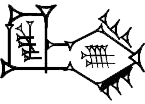
Values: sumur3
| ETCSLglossing |  | Sign name: MUNSUB (MUNŠUB) Values: sumur3 |
| ĝišgag | e2-ĝar8-a-na | ab-du3-a | gig-ga | i-i |
| gag | e2-ĝar8 | du3 | gig | i |
| peg | wall | to erect | to be ill | to bring out |
| "Did you see him who had one son?" "I saw him." "How does he fare?" "He weeps bitterly at the wooden peg which was driven into his wall." "Did you see him who had two sons?" "I saw him." "How does he fare?" "He sits on a couple of bricks, eating bread." "Did you see him who had three sons?" "I saw him." "How does he fare?" "He drinks water from a saddle waterskin." "Did you see him who had four sons?" "I saw him." "How does he fare?" "His heart rejoices like a man who has four asses to yoke." "Did you see him who had five sons?" "I saw him." "How does he fare?" "Like a good scribe he is indefatigable, he enters the palace easily." "Did you see him who had six sons?" "I saw him." "How does he fare?" "He is a cheerful as a ploughman." "Did you see him who had seven sons?" "I saw him." "How does he fare?" "As a companion of the gods, he sits on a throne and listens to judgments." |
| ePSD = The Pennsylvania Sumerian Dictionary |
 |
© Copyright 2003, 2004, 2005, 2006 The ETCSL project, Faculty of Oriental Studies, University of Oxford |
 |